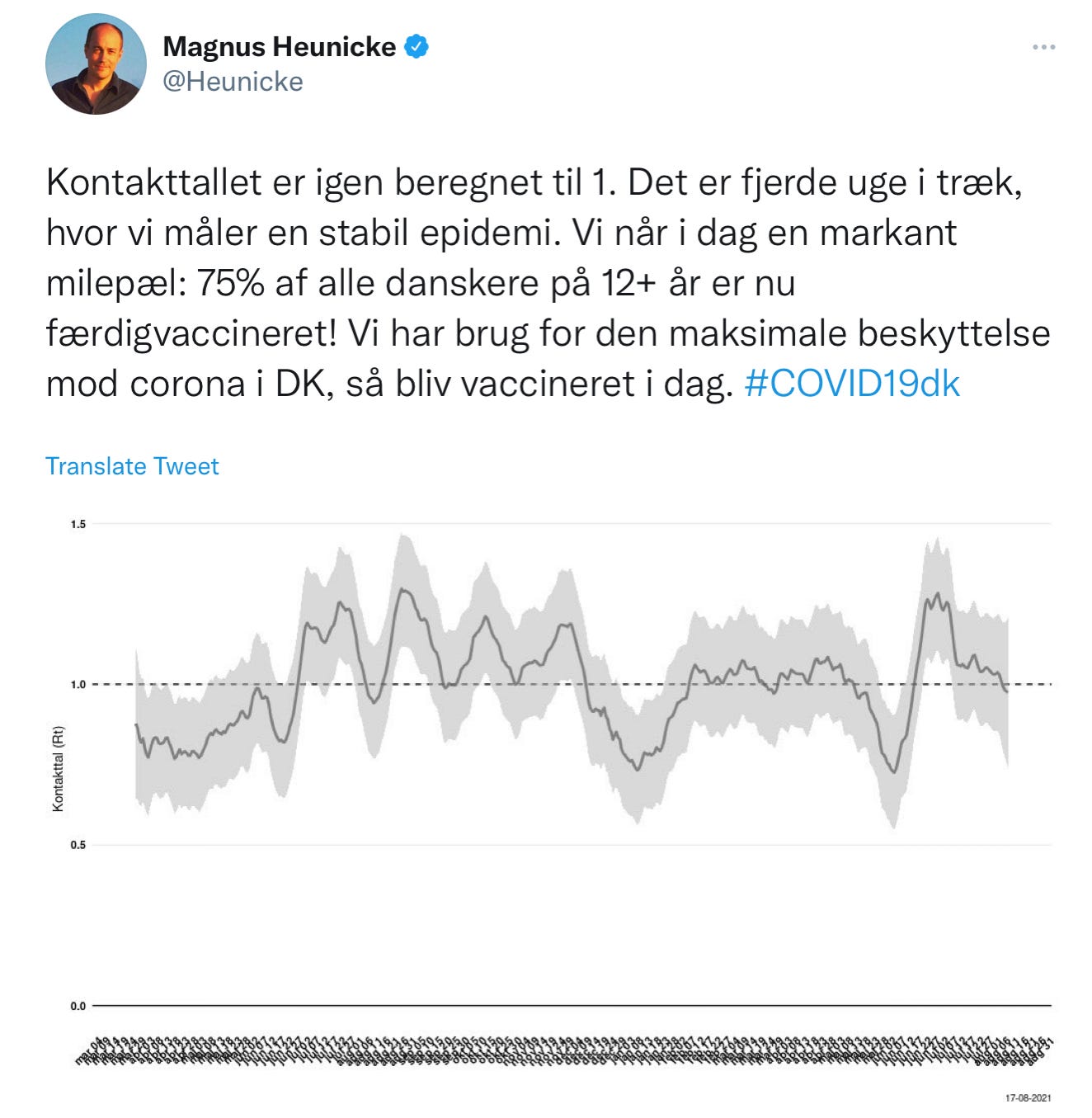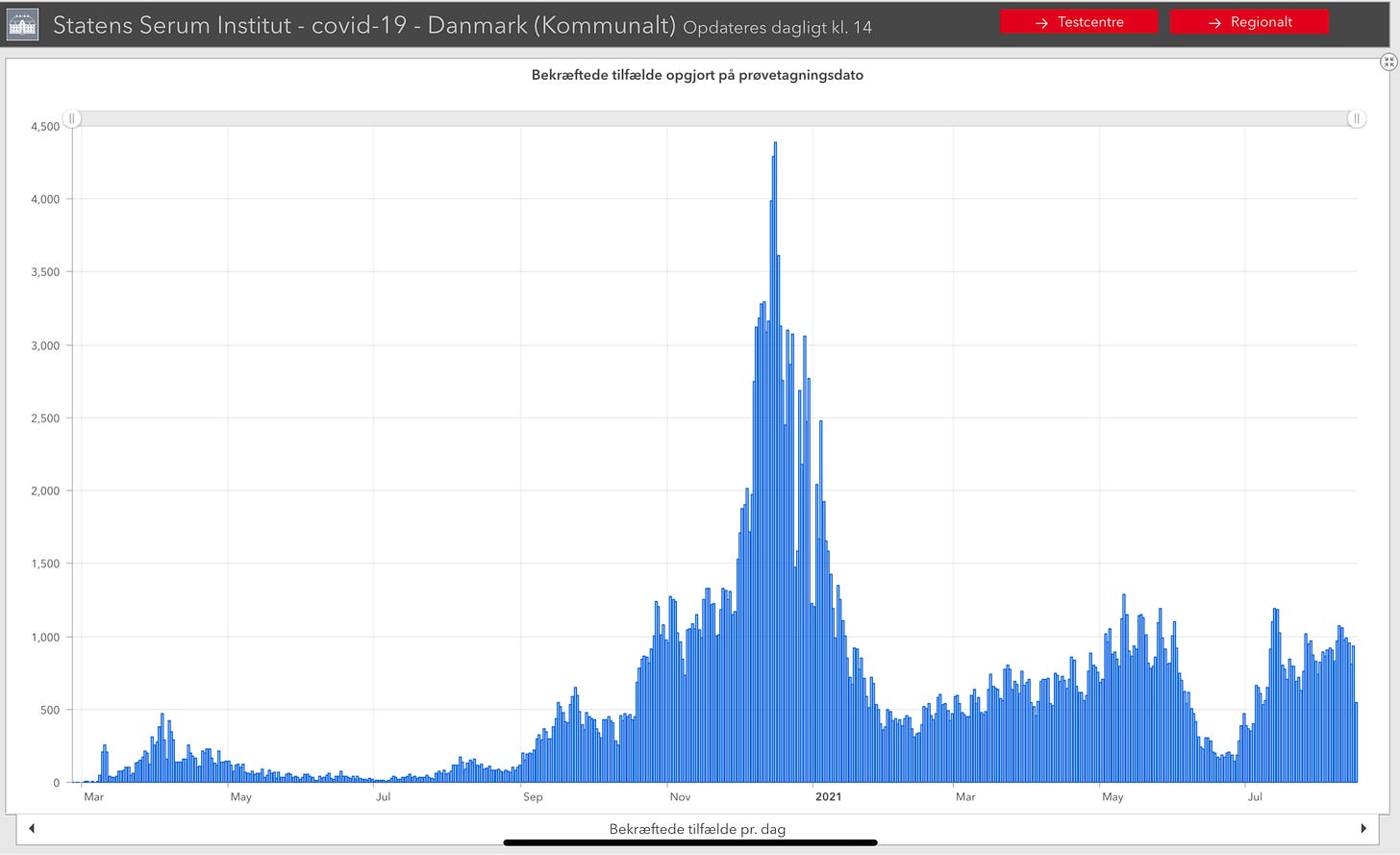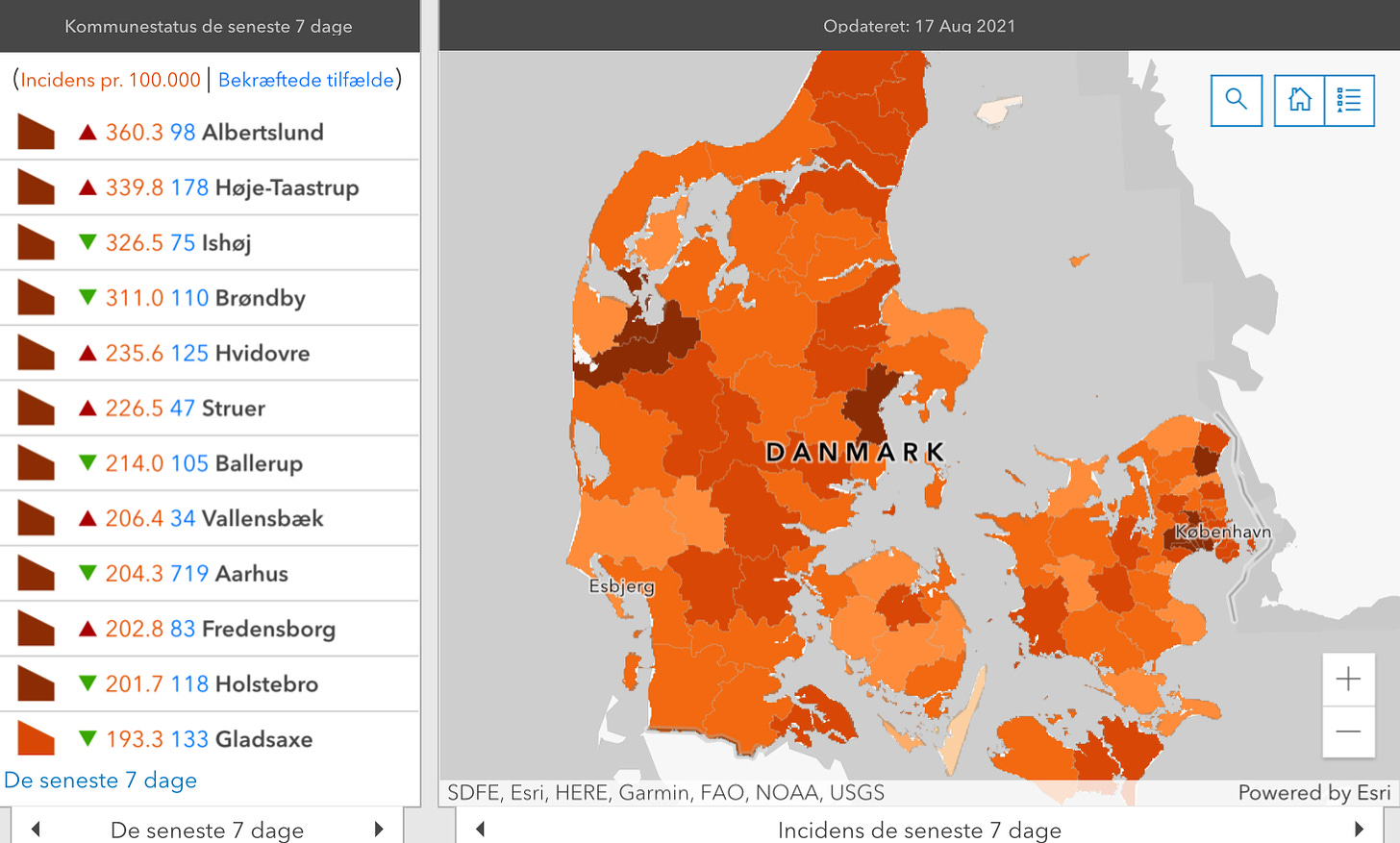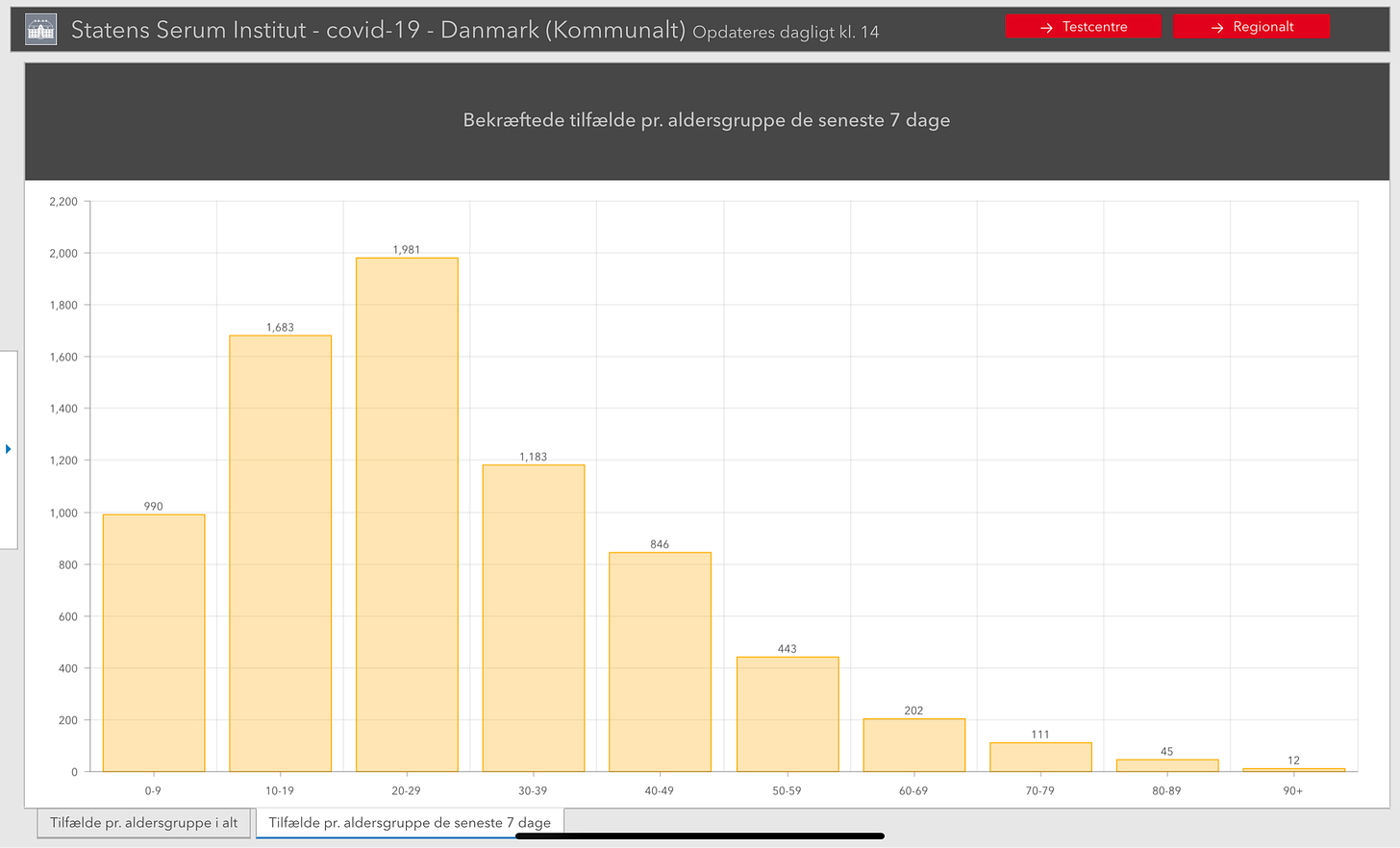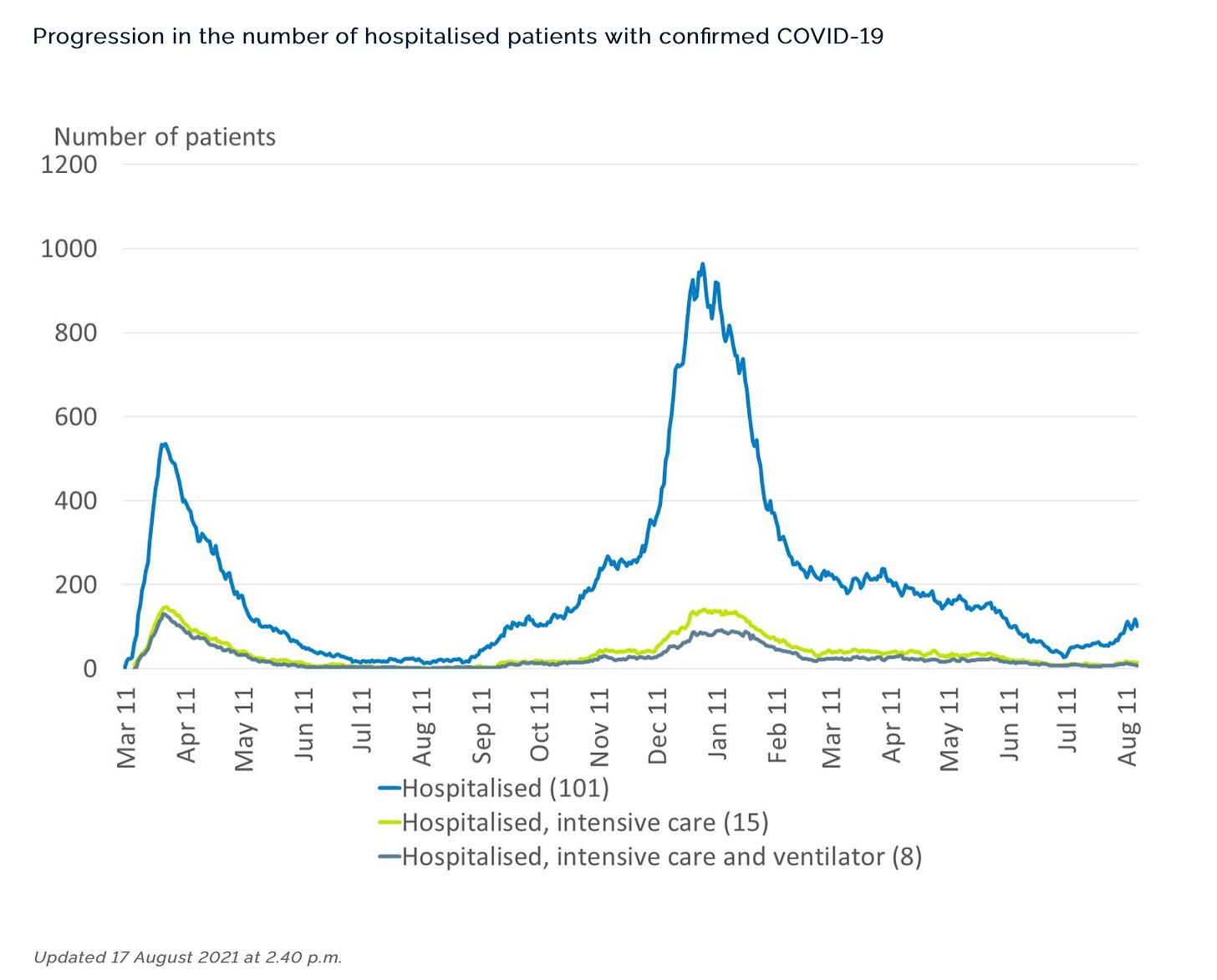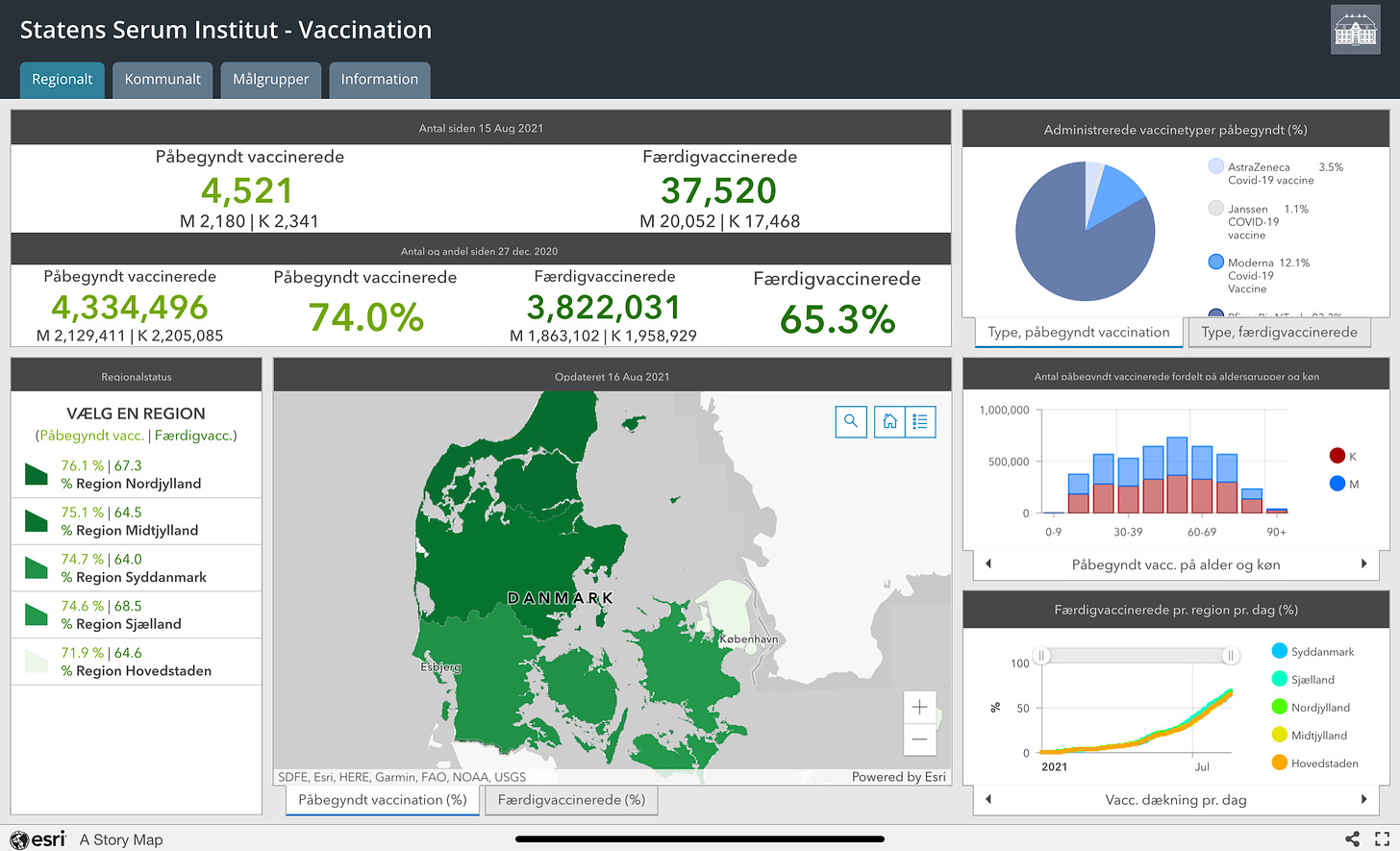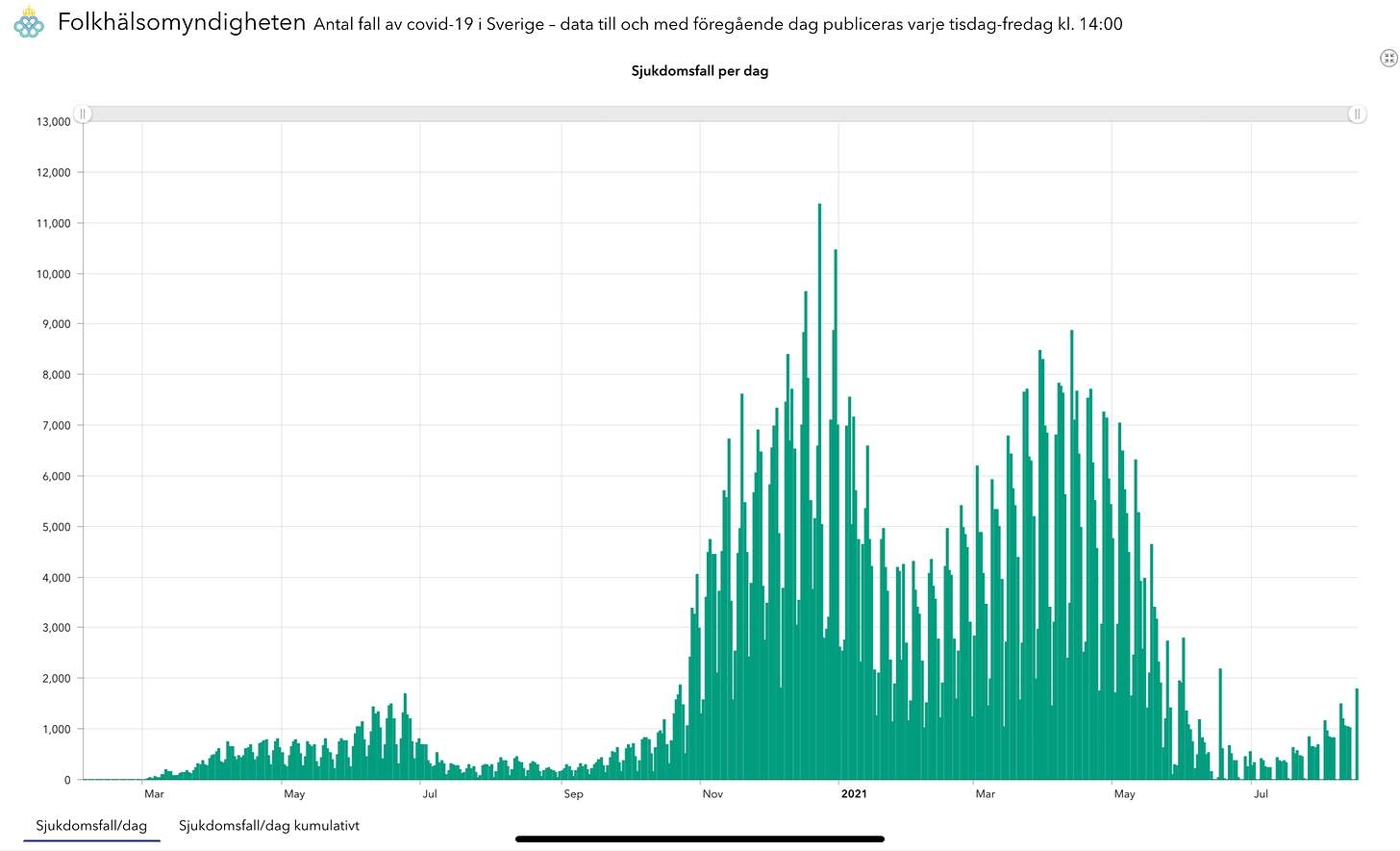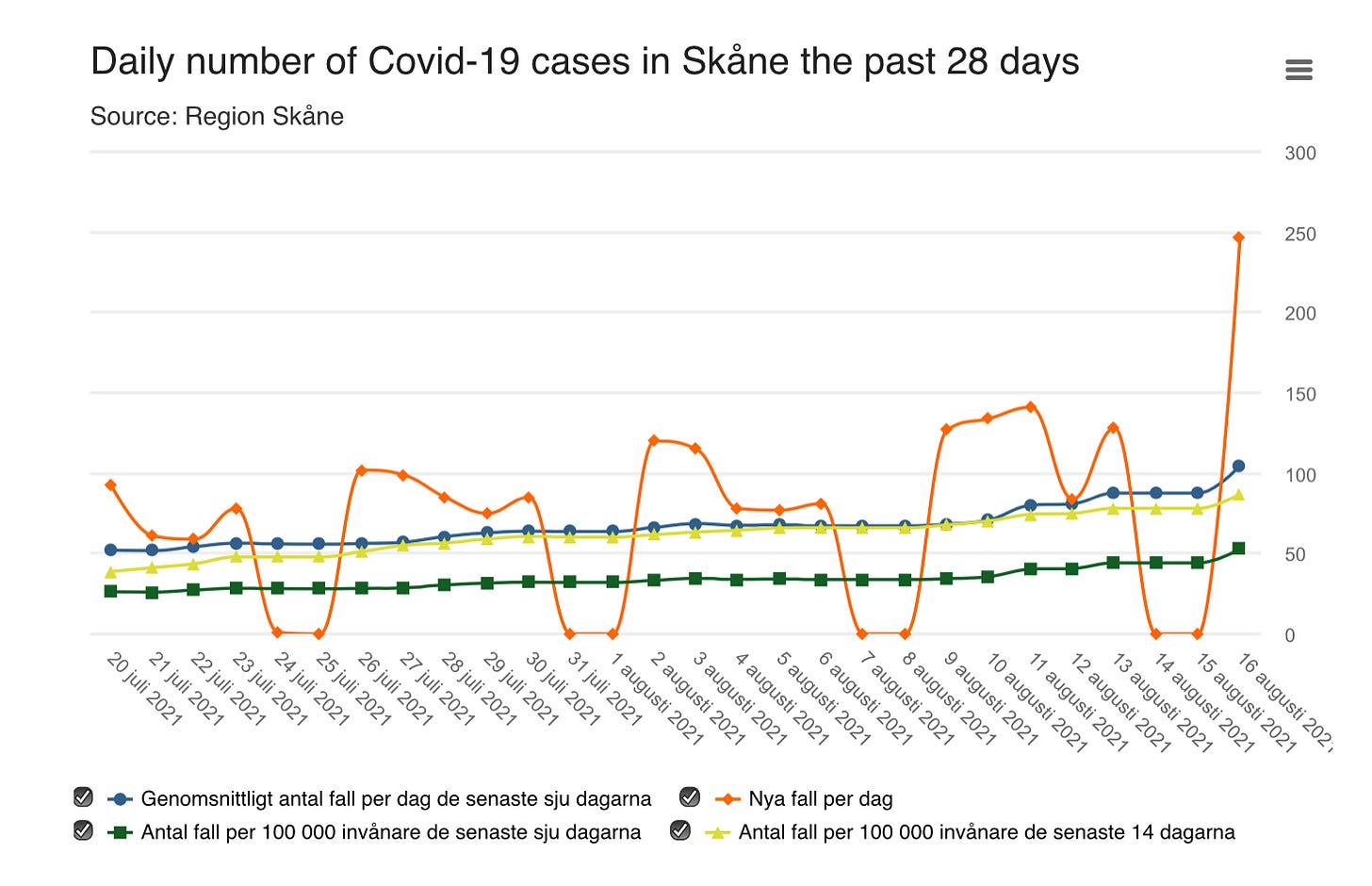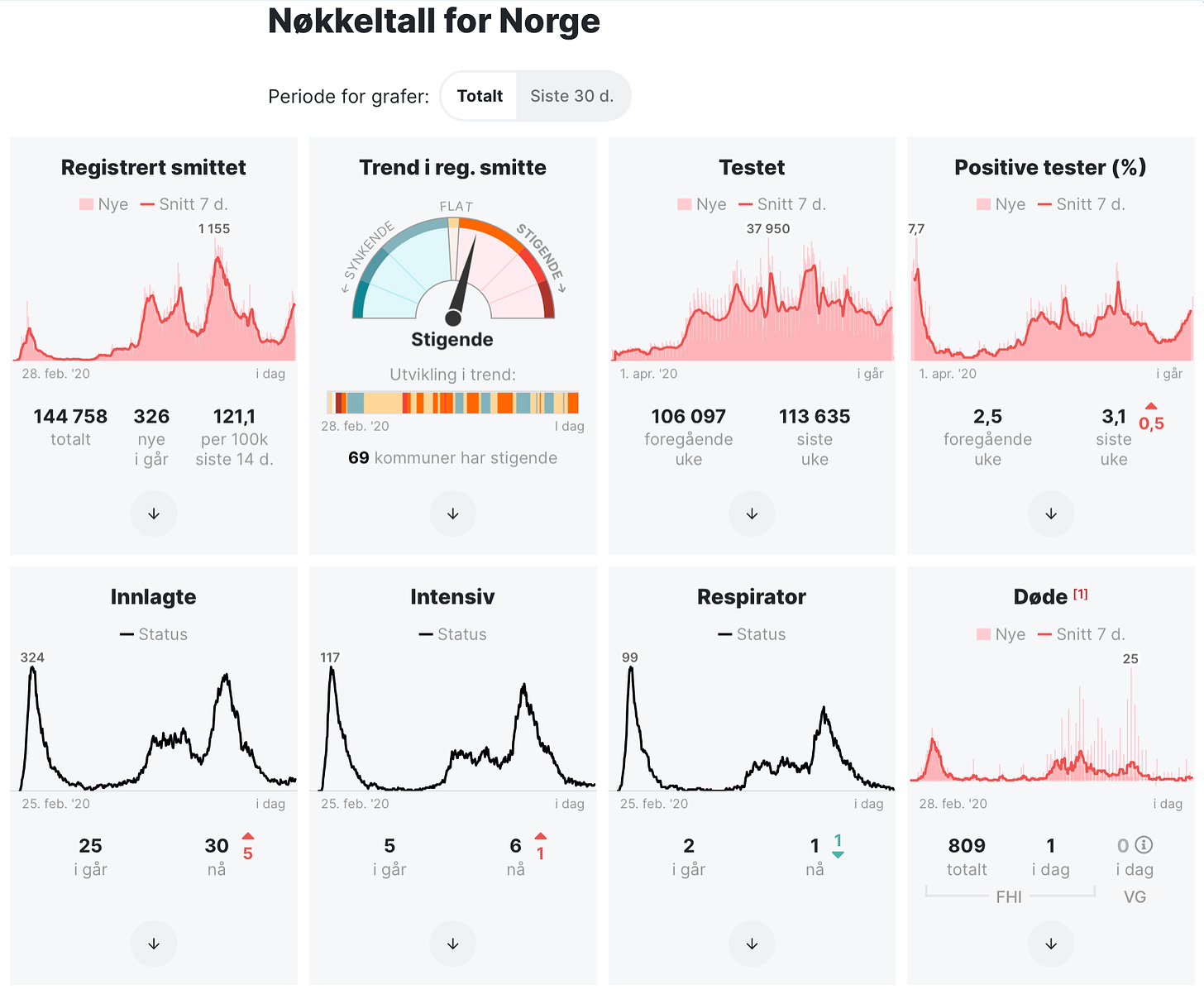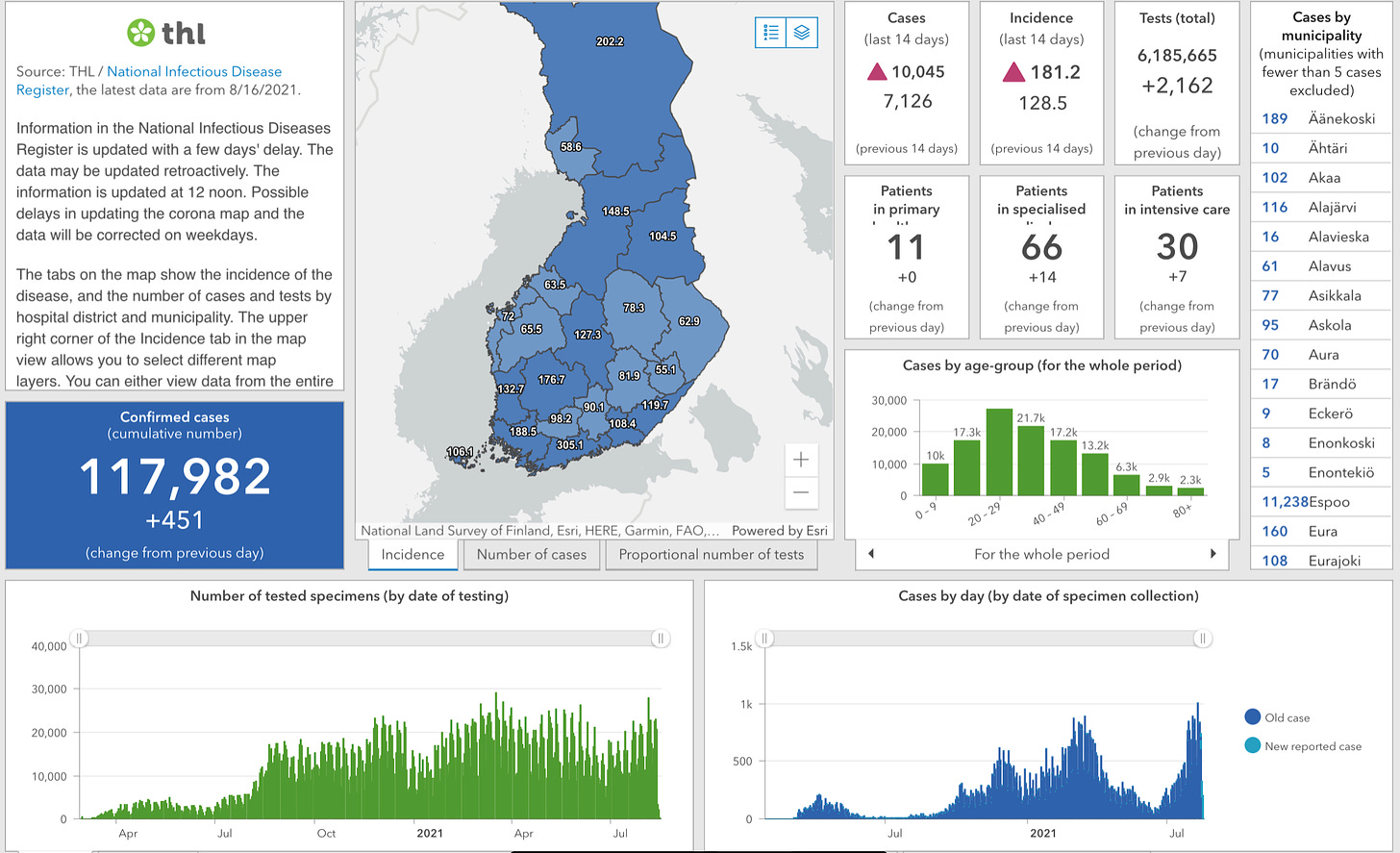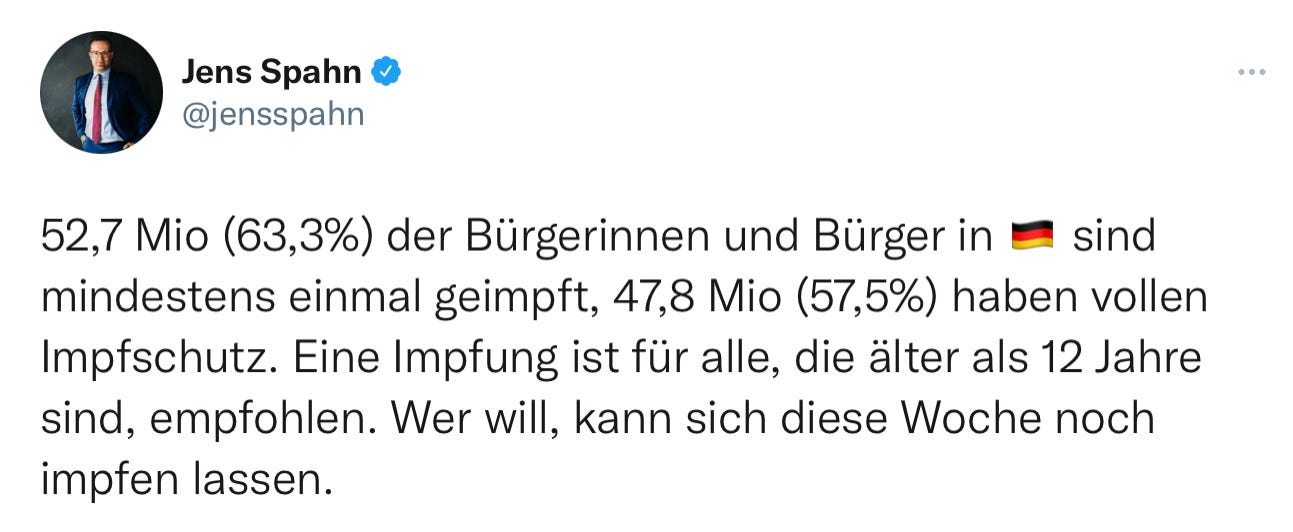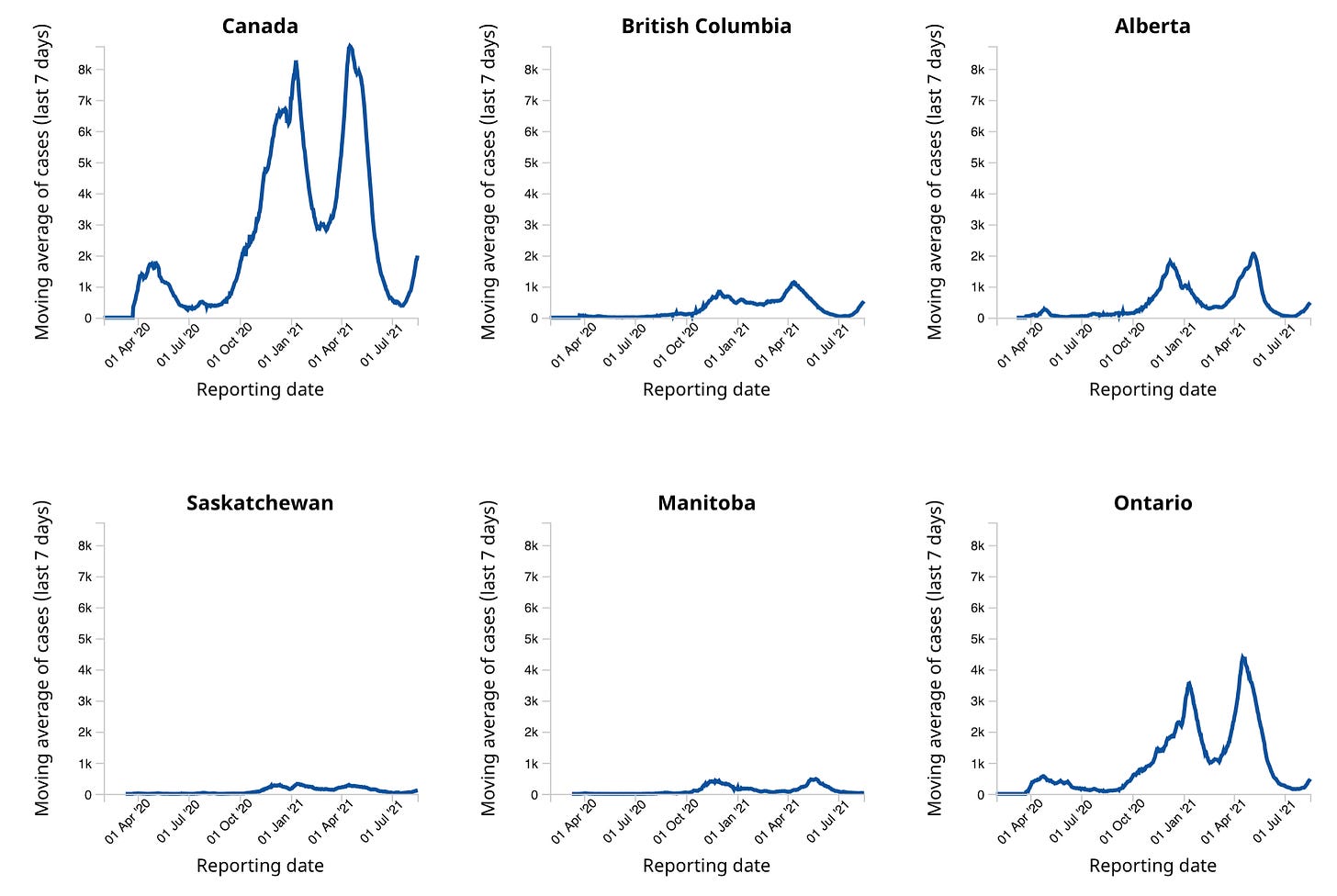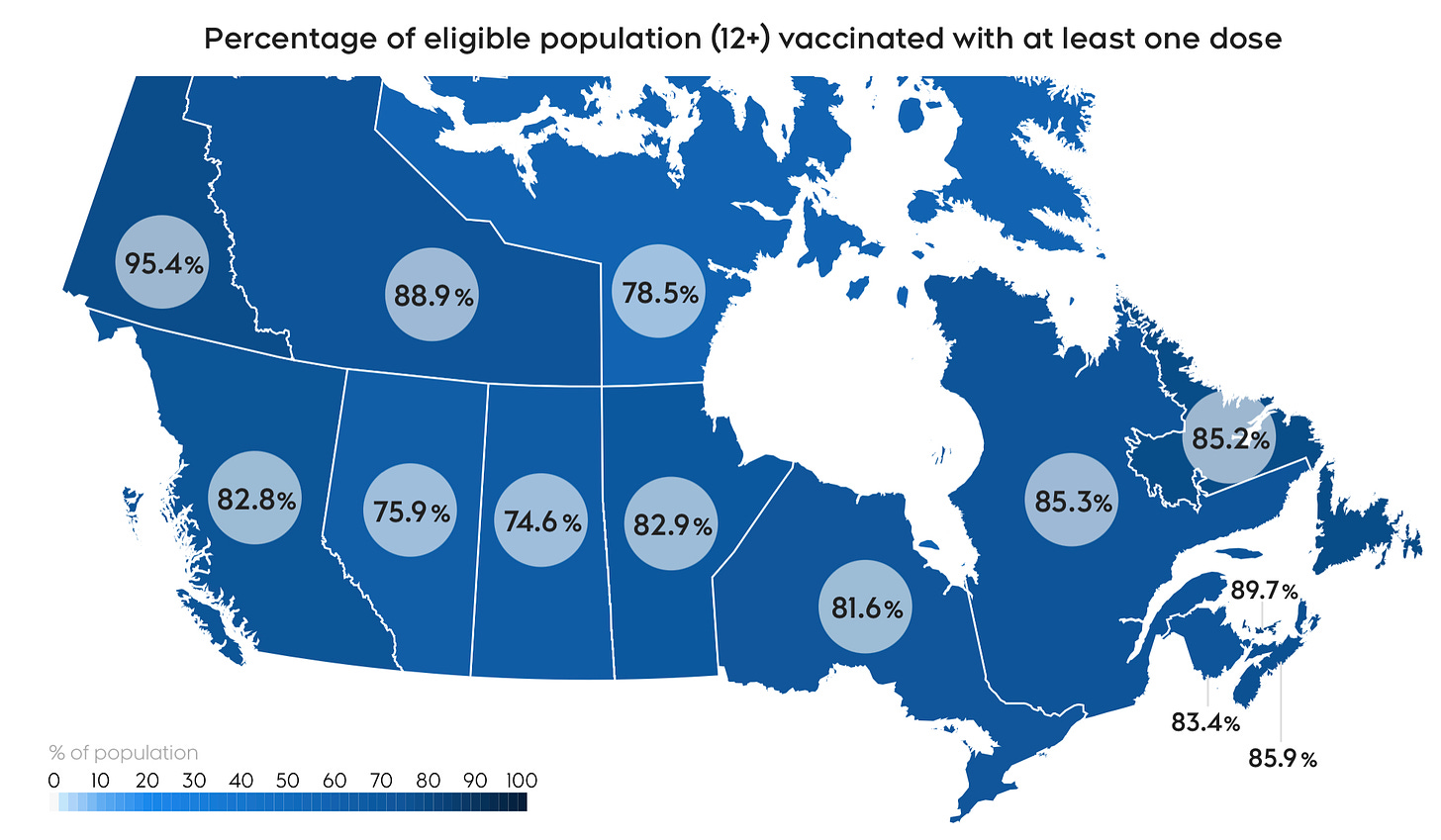The Evening Report - Aug 17
Denmark’s vaccination campaign is now all about convincing the hesitant
🇩🇰
Denmark’s Health Minister Magnus Heunicke says the COVID contact number (reinfection rate or R0) remains at 1.0 for a fourth week in a row. He says the epidemic continues to be “stable.”
Heunicke is also applauding the passing of another vaccination milestone, with 75% of the Danish population over the age of 12 now fully vaccinated.
-
Politiken has obtained yet to be published data from Denmark’s Staten Serum Institute that paints a very concerning picture of the potency of the Delta variant. The data from the institut has found that the Delta variant triples the risk of hospitalization for those who are not yet vaccinated. The variant has already been found to be about doubly as contagious as the original coronavirus that triggered the global pandemic last year. The SSI and other health authorities in Denmark are urging young people and anyone else who is not yet vaccinated to not waste anymore time and get their shots.
-
Another sign of a slowing vaccination campaign in Region Midtjylland’s latest weekly vaccination update. The region says for the first time since the national inoculation campaign began, it’ll receive no new vaccine doses this week from the Staten Serum Insititut. The region says slowing demand a having a built-up supply of doses on hand, it doesn’t need any new vaccine supplies.
All prisoners in the region have now been vaccinated.
Regional Council Chairman Anders Kühnau says the majority of the region’s population will be vaccinated by October and the health authority is now preparing to scale down its vaccination efforts.
“When there was the most pressure, we vaccinated almost 150,000 citizens in one week. In comparison, we only expect to vaccinate between 2,000 to 7,000 citizens a week during the autumn, and therefore we are in the process of adjusting capacity, staff, and opening hours.”
The region is planning to close three of its large vaccination centers, going from seven to four, as well as closing all other local sites.
Keeping with the national effort to take vaccination opportunities to young people, the mid-Jutland health authority had a pop-up clinic at Silkeborg Gymnasium last week. It says discussions are underway to do something similar at Aarhus University soon.
To date, 1,004,055 (75.1%) of the people in Midtjylland have had one dose and 856,400 (62%) have had both.
-
The city of Copenhagen is working with Region Hovedstaden and the National Health Board in an effort to target vaccinations directly to areas of the city where uptake is the lowest.
Health and Care Mayor Sisse Marie Welling:
"We have come a long way with the vaccination effort in Copenhagen, but we are not not done yet. There are areas in the city where the vaccination rate is significantly lower than in the rest of the city, and we would like to rectify this. We know from our experience from Tingbjerg that it really moves the needle if we make it easier for people to get inoculated.”
A targeted vaccination effort was launched in Tingbjerg a few weeks ago and ended up inoculating 2,400 people. This time the city is hoping to take what worked there and open it up for the whole city beginning this week in nine different locations.
The campaign will see pop-up vaccination centers offering shots on a walk-in basis to anyone who has not yet had their shots. The campaign will be backed up with messages sent to people’s e-Boks, text messages, posters in the streets, and in doctor’s offices.
Jonas Egebart, Chief Medical Officer at Nordsjællands hospital, says in Region Hovedstaden, after getting another 4,000 people started on the vaccination process, they have just 263,000 people left in the region who have yet to have their shots. He says the capital region is seeing a vaccination rate of 83%.
-
Region Sjælland is leading the Danish health regions in an effort to bring vaccinations directly to school campuses. It began last week when students returned to school, and this week the region says it is opening pop-up vaccination centers in another 13 education institutions. Young people aged 20 to 29 years old have the lowest vaccination rates and highest number of new infections of any other age group in Denmark.
-
Denmark added 1,844 COVID infections and two more coronavirus deaths in the last 48 hours. Yesterday it reported 959 infections and then another 886 today.
Yesterday there was 147,552 total corona tests done, 55,875 PCR and 91,677 rapid, for a (PCR only) positivity percentage of 1.58%.
The number of Danish kommunes with COVID incidence rates over 100 per 100,000 people has risen slightly to 41, with 11 of those municipalities seeing incidence rates above 200.
The incidence rates in just over half of the kommunes continue to trend upward.
Vollsmose Parish in Odense Kommune is flirting with an automatic shutdown. It currently exceeds two of the three requirements and is fast approaching the third. An automatic lockdown happens when a district has a corona incidence rate of 1,000 or more per 100,000 residents, more than 20 infections, and a positivity percentage exceeding three. Currently, Vollsmose has a positivity percentage of 8.48%, well above threshold. It has also recorded 77 coronavirus cases, well over the limit of 20. The incidence rate is currently 776, almost double what it was a week ago, if it exceeds 1,000 schools, SFOs, swimming pools, sports facilities, and cultural institutions must all close.
-
Young people continue to be a major infection concern in Denmark, with the number of new cases highly concentrated among those 10 to 39 years old, especially among the 20 to 29 years of age group, which continues to lead all others in the number of new infections in the last seven days.
-
After jumping up to the highest point since mid-June yesterday, COVID hospitalizations (101) dropped back down today (-16) while the number of infected people in an ICU (15) is unchanged day to day; of those, the number on a ventilator (8) edged downward (-2).
Svend Ellermann-Eriksen, Chief Physician at the Department of Microbiology at Aarhus University Hospital, spoke to Ritzau about the rising hospital numbers.
“If the number continues to rise, it starts to get worrying. But right now the number is relatively stable. The ultimate goal is to reduce the number of people who get serious problems and end up in hospital, and therefore the number of hospitalized is the most important number to keep an eye on.”
-
On the vaccination front to date, enough 1st vaccine doses have been administered to cover 74.2% of the population while 66.1% are now fully vaccinated.
Yesterday there were 51,433 total inoculations done. 6,777 of those were 1st doses, a slight uptick from the day prior.
It’s also worth noting that the gap between first and second doses continues to close as the number of second shots continues to dwarf first inoculations.
-
A reminder from Region Hovedstaden today that drop in vaccination opportunities are available without needing an appointment every day in the capital region. Vaccination sites are taking everyone who wants to get vaccinated from 9am to 6pm in Metro Copenhagen and on Bornholm drop-in vaccinations are available from 9am to 4pm. Opening hours of the vaccination centers can be found HERE.
🇸🇪
Sweden has added 2,811 infections and one corona death since Friday’s update. Its infection curve continues to head back upward.
To date, 6,573,678 1st doses (80.3% of the adult population 18 years old and older) and 4,921,526 2nd vaccine doses (60.1%) have been administered.
-
The number of infections in Skåne continues to rise increasing 32% last week compared to the week previous, according to a press release from the region. While infections are rising across the region, the highest numbers are being seen in the Malmö area.
Assistant Infection Control Doctor Eva Gustafsson:
“Unfortunately, the negative development that has been going on for a few weeks continues. In most cases, it continues to be in the age groups from 5 years old up to 39. This makes it extra important that the schools do everything possible to prevent the spread of infection now that a new school year is starting.”
The vaccine uptake among 16 and 17 year olds in the region seems to be fairly high, with 32% already having a first dose.
Vaccination Coordinator Maria Landgren:
“Before starting school, it is extra important to get vaccinated. It is gratifying that so many of high school age are taking the chance to help reduce the spread of infection. Right now there are plenty of times to get vaccinated and therefore young people should take advantage.”
-
While students in most of Sweden return to class this week, that won’t be the case for some kids in Tranås in Småland. Due to a COVID outbreak among teens grades one to three and eight and nine have had their back to school postponed. If all goes well, they’ll begin classes on August 23 instead. The outbreak of coronavirus cases comes from a combination of parties, summer camps, and sporting activities.
-
As students in Sweden head back to class, the country’s National Association of Teachers is pushing health authorities to vaccinate children as young as 12 years old.
Åsa Fahlén, the Chair of the National Association, spoke to TT.
“Before the start of school, we see that there is an increased spread of infection in society in general and we know that it has been difficult, if not impossible, for schools to follow the Public Health Agency's recommendations to keep their distance.”
Currently, Sweden has just invited those 16 to 17 years old to begin the vaccination process. The Public Health Agency in Sweden has so far not indicated when it might make a decision whether to vaccinate adolescents. All three of its Nordic neighbours have begun vaccinations for children as young as 12.
🇳🇴
Norway has added 1,091 new infections and two more virus deaths in the last 48 hours. It reported 449 cases yesterday and another 642 today.
COVID hospitalizations (32) and the number of people in an ICU (8) are both up (+2 each) ventilator numbers (4) have also increased (+3).
To date, 69.94% of Norwegians have and one vaccine dose and 41.80% have had both.
-
The Norwegian Institute for Public Health has done a study that in part looked at the pandemic’s impacts on children and young people. It found that children from vulnerable families were more likely to suffer negative consequences. Specifically, children from families with parents who have a low level of education, small social circles, poor finances, or who are migrants who struggle with the language barrier.
However, the results as a whole weren’t entirely negative. The study also found many children benefited from more quality time with their family as well having less social pressure from being in school.
NIPH’s Heid Nøkleby:
“The biggest difference from the previous study is that there is now far more published research on different consequences for children and young people. Among other things, there were several studies from Norway and several studies that had measured actual change, ie they had made measurements both before and during the pandemic.”
Nøkleby says the pandemic has been both a blessing and a curse from a research perspective in providing a plethora of studies and resulting data but also leaving important unanswered questions like the long-term consequences. The health agency believes more studies with longer follow-up periods are needed.
🇫🇮
Finland has added 1,116 in the last two days. It reported 451 infections yesterday and another 665 today.
COVID hospitalizations (104) have dipped (-3) while ICU numbers (31) inched upward (+1).
To date, 3,859,628 1st doses (69% of the population) and 2,387,605 2nd vaccine doses (42.8%) have been administered.
🇩🇪
“Every vaccination counts!” Germany’s Health Minister Jens Spahn is urging people to get vaccinated as the rate of first doses administered in the country begins to sputter. Spahn says to date 52.7 million people (63.3%) have had their first dose and 47.8 million (57.5%) are fully vaccinated.
🇳🇿
New Zealand has imposed a snap three day national lockdown beginning Tuesday night after a single COVID case was confirmed. In the Auckland and the nearby Coromandel area restrictions will last one-week. The country has until now not recorded a single infection via community spread in six months. New Zealand Prime Minister Jacinda Ardern said with the Delta variant they are not taking any chances.
"We have seen what can happen elsewhere if we fail to get on top of it. We only get one chance. We are better to start high and be cautious, then move out as soon as we are comfortable doing so, than to start low and be in that [lockdown] phase for much, much longer. You only need to look at Australia to see the alternative.”
The main reason for severe response is that the COVID case identified in Auckland has no obvious connection to travel.
🇨🇦
Canada reported 1,973 infections and five more coronavirus deaths yesterday as the national infection curve continues to rise, as it also does in British Columbia, Alberta, Ontario, and Quebec.
The Canadian vaccination effort has so far has administered 27,457,298 1st vaccine doses (72.12% of the population) while 24,321,585 people (63.88%) are fully vaccinated.
In Ontario there were 526 new infections yesterday, of which 67% were among people who hadn’t been vaccinated. Today there were 348 infections reported, with 203 cases among unvaccinated people and 49 among those who are partially vaccinated.
Quebec reported 323 new corona cases today with no new deaths.
In Atlantic Canada, New Brunswick has 13 new infections, with 110 active cases currently of those, most are unvaccinated. Nova Scotia recorded one new infection. Newfoundland and Labrador had three.
Manitoba saw 24 new infections and one death today. Over the weekend, it reported 77 new corona cases and three more fatalities.
There were 85 new COVID cases in Saskatchewan yesterday, of which 74 were unvaccinated people.
Alberta logged 392 infections and one more corona death yesterday. It reported over a 1,000 new COVID cases over the weekend. There are 161 people in hospital of which 73.6% are unvaccinated. There are also 43 people in an ICU of those 90.7% are unvaccinated.
B.C. registered an average of 478 new infections since Friday, which is a 33% increase from the previous weekend. There are 104 people in hospital, the highest since early July, and the number of people in an ICU have doubled in a week to 47.



